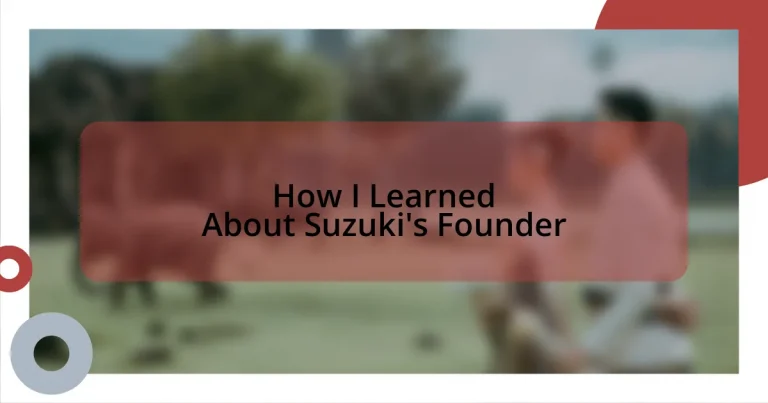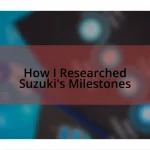Key takeaways:
- Michio Suzuki, born in 1887, transitioned from crafting loom machines to founding a successful automobile company, showcasing the spirit of entrepreneurship through innovation and perseverance.
- He pioneered compact car designs like the Suzulight, adapting to urban needs and introducing four-wheel drive technology and fuel-efficient engines, emphasizing environmental sustainability.
- Suzuki’s leadership focused on employee empowerment, quality over quantity, and adaptability to market changes, influencing corporate cultures that prioritize inclusivity and innovation today.

Introduction to Suzuki’s Founder
When I first stumbled across the story of Michio Suzuki, I was captivated by his humble beginnings. Born in 1887 in a small Japanese village, he started out crafting loom machines, driven by a vision that stretched far beyond his circumstances. Isn’t it incredible how one person’s determination can shape industries?
Suzuki’s curiosity and ingenuity led him on a journey from making looms to creating his own automobiles. It’s a transformative leap that really makes you think about how passion can drive innovation. For me, this journey reflects the quintessential spirit of entrepreneurship; it’s about embracing risks and learning along the way.
Reflecting on Suzuki’s life, I often wonder what inner strength fueled his relentless perseverance against all odds. His commitment to quality and craftsmanship resonates deeply, showcasing that success often springs from a blend of vision, hard work, and an unparalleled dedication to one’s craft. Isn’t it inspiring to think about how such foundational ideas still hold true in today’s fast-paced world?
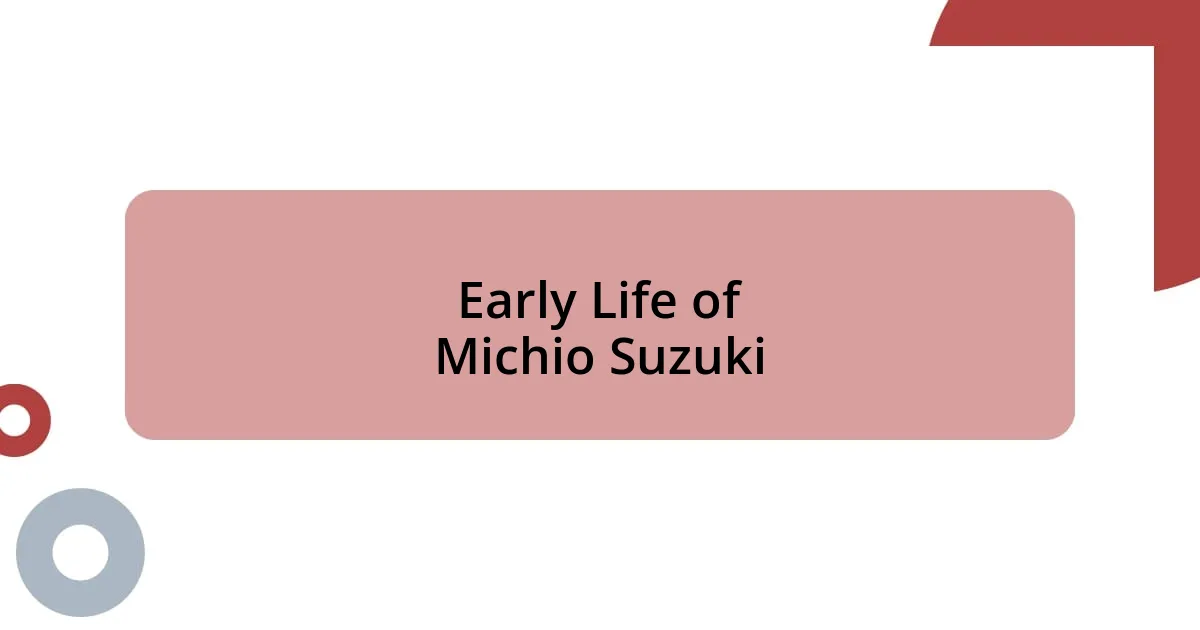
Early Life of Michio Suzuki
Born into a farming family, Michio Suzuki’s childhood was anything but affluent. Growing up during a time of significant change in Japan, he experienced firsthand the struggles of rural life. I remember thinking about how challenging it must have been for a young boy to envision beyond the fields he worked in daily. His fascination with machinery began early, as he repaired and crafted parts using whatever materials he could find. This resourcefulness, which I find so admirable, laid the groundwork for the innovative spirit he would later embody.
As a teenager, Suzuki moved to Hamamatsu to work as an apprentice in a local loom factory. There, he honed his skills and developed a keen eye for detail. I can’t help but draw parallels between Suzuki’s early work and how I learned my craft—through patience and practice, slowly mastering each technique. The experience likely fueled his ambition and desire to improve upon existing designs, establishing a solid foundation for the ambitions of his later life.
In the early 1900s, young Michio’s decision to start his own business marked the beginning of a remarkable journey. Drawing inspiration from the looms he worked with, he eventually began to innovate and adapt, creating new loom machines that stood out in the market. The emotion I feel when I think about his ability to turn a small venture into something transformative is immense. It’s a reminder of how passion and tenacity can propel us forward, even when the odds seem stacked against us.
| Fact | Details |
|---|---|
| Birth Year | 1887 |
| Early Profession | Craftsman of Loom Machines |
| Apprenticeship Location | Hamamatsu |
| Transition to Business | Started his own company in the early 1900s |
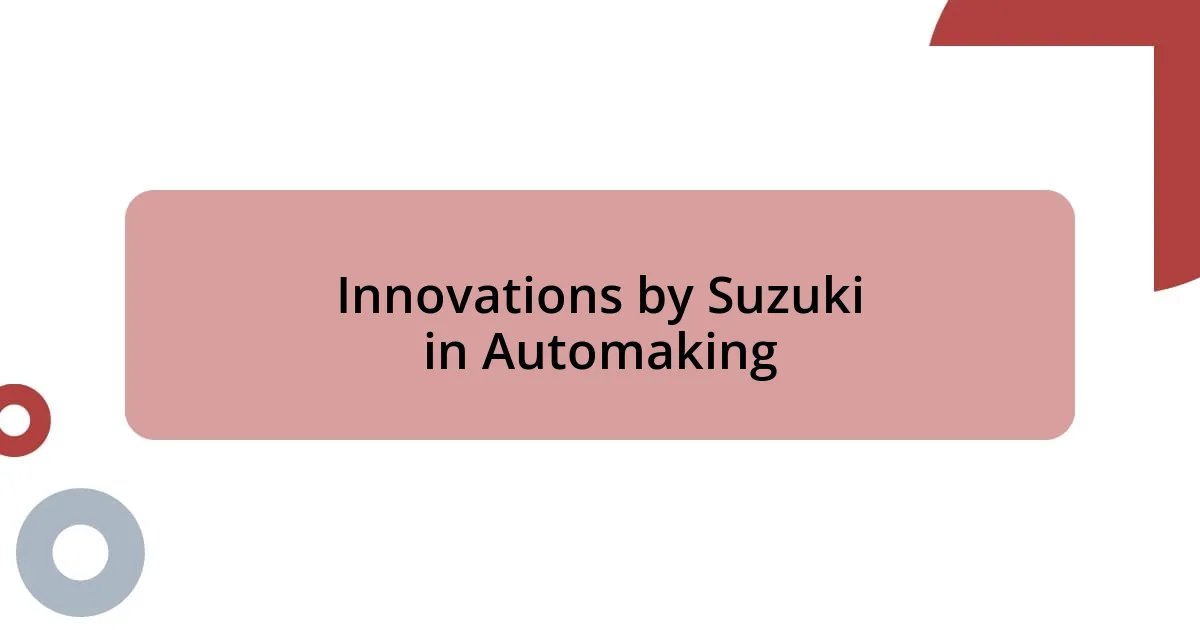
Innovations by Suzuki in Automaking
It’s fascinating to explore how Suzuki’s innovations in automaking were not just about technology but also about a vision. For instance, he pioneered the concept of compact cars tailored for the Japanese market, allowing his vehicles to navigate the narrow streets and limited space typical of urban areas in post-war Japan. I often think about how these decisions were ahead of their time, reflecting a deep understanding of the needs of his customers.
Here’s a closer look at some specific innovations introduced by Suzuki:
- Compact Car Design: Suzuki introduced smaller vehicles like the Suzulight, which catered to urban dwellers and contributed to the kei car market.
- Four-Wheel Drive Technology: The company was among the first to incorporate four-wheel drive systems into compact vehicles, paving the way for adventures off the beaten path.
- Motorcycle Development: Suzuki’s foray into motorcycles allowed them to master engine technology, which would later enhance the performance of their cars.
- Environmental Awareness: In the 1990s, Suzuki invested in developing more fuel-efficient engines, aligning with growing global concerns about sustainability.
- All-Wheel Drive Systems: Innovations such as the all-wheel drive systems improved the versatility and safety of Suzuki vehicles, enhancing their appeal in various markets.
When I think about these innovations, I can’t help but appreciate how they improved the lives of many. Imagine driving a compact car that fits perfectly in tight spaces yet offers remarkable capability – it’s a blend of practicality and ingenuity that I’ve come to admire in automotive design. The notion that a single individual’s vision can ripple through an entire industry is something that truly resonates with me.

Lessons from Suzuki’s Leadership Style
Suzuki’s leadership style is rooted in a remarkable blend of humility and innovation. He believed in empowering his workforce, fostering an environment where everyone felt valued. I remember reading about how he often engaged with his employees directly, encouraging their ideas and feedback. Isn’t it inspiring to think about how such an inclusive approach can drive creativity and motivation in any organization?
What truly stands out to me is Suzuki’s commitment to quality over quantity. He understood that producing reliable, well-crafted vehicles was paramount to building trust with consumers. This reminds me of the times when I’ve prioritized quality in my own projects, realizing that the effort pays off in the long run. Have you ever felt that sense of pride in delivering something that truly reflects your values and standards?
Finally, Suzuki’s adaptability is a cornerstone of his leadership legacy. As markets changed, he didn’t shy away from evolving his business strategies. Instead, he embraced new ideas and technologies, positioning his company for future success. I often reflect on my own experiences of needing to pivot in response to changing circumstances. How adaptable are we in our day-to-day lives? Suzuki’s journey reminds us that a flexible mindset can lead to resilience and growth, both as individuals and within our endeavors.
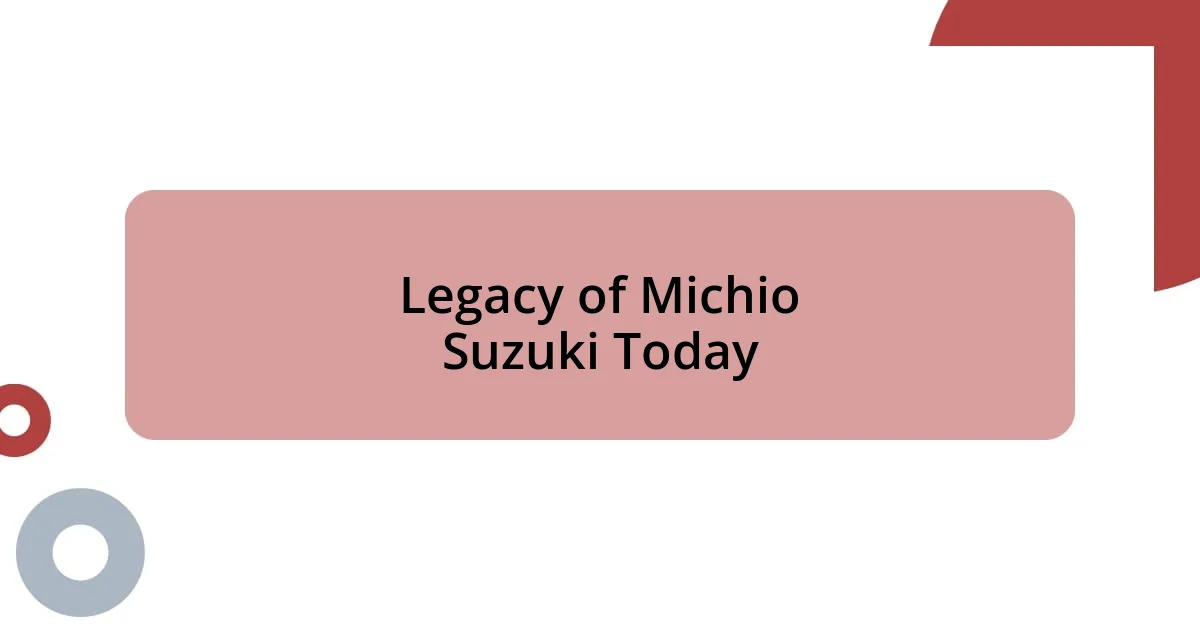
Legacy of Michio Suzuki Today
When I think about Michio Suzuki’s legacy today, it strikes me how his vision has transcended time. The blend of innovation and practicality in Suzuki vehicles continues to shape the automotive industry. Every time I see a compact Suzuki parking effortlessly in a bustling city, I appreciate the foresight he had in understanding urban living needs.
Suzuki’s emphasis on environmental sustainability is also a testament to his forward-thinking approach. His early investments in fuel-efficient technology resonate with our current global priorities. It amazes me how this vision of sustainability can still inspire newer generations of automakers. Have you ever considered how a single person’s beliefs can influence entire industries? It’s a profound thought that weaves through Suzuki’s legacy.
Moreover, the impact of his leadership principles is evident in corporate cultures today. As companies strive for inclusivity and innovation, I often reflect on how much more effective a workplace feels when every voice counts. When was the last time you felt truly heard while sharing your ideas? Suzuki showed that a thriving community leads to groundbreaking advancements, and it’s a reminder I carry into every collaborative project.












